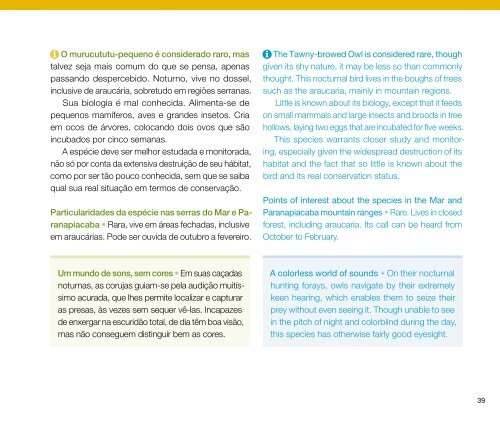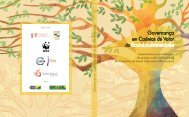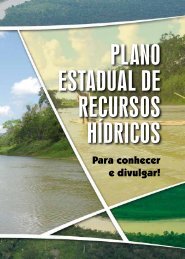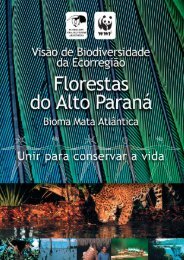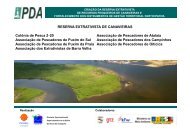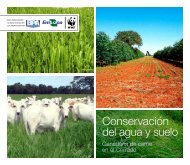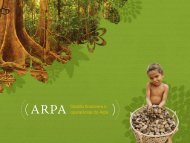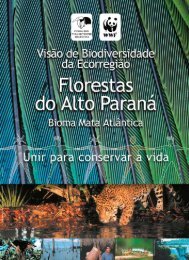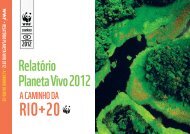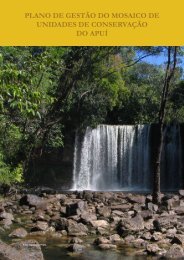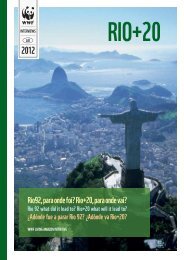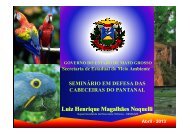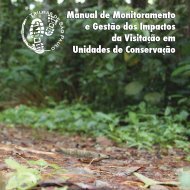Guia de aves Mata Atlântica Paulista
Guia de aves Mata Atlântica Paulista
Guia de aves Mata Atlântica Paulista
You also want an ePaper? Increase the reach of your titles
YUMPU automatically turns print PDFs into web optimized ePapers that Google loves.
O murucututu-pequeno é consi<strong>de</strong>rado raro, mas<br />
talvez seja mais comum do que se pensa, apenas<br />
passando <strong>de</strong>spercebido. Noturno, vive no dossel,<br />
inclusive <strong>de</strong> araucária, sobretudo em regiões serranas.<br />
Sua biologia é mal conhecida. Alimenta-se <strong>de</strong><br />
pequenos mamíferos, <strong>aves</strong> e gran<strong>de</strong>s insetos. Cria<br />
em ocos <strong>de</strong> árvores, colocando dois ovos que são<br />
incubados por cinco semanas.<br />
A espécie <strong>de</strong>ve ser melhor estudada e monitorada,<br />
não só por conta da extensiva <strong>de</strong>struição <strong>de</strong> seu hábitat,<br />
como por ser tão pouco conhecida, sem que se saiba<br />
qual sua real situação em termos <strong>de</strong> conservação.<br />
Particularida<strong>de</strong>s da espécie nas serras do Mar e Paranapiacaba<br />
• Rara, vive em áreas fechadas, inclusive<br />
em araucárias. Po<strong>de</strong> ser ouvida <strong>de</strong> outubro a fevereiro.<br />
The Tawny-browed Owl is consi<strong>de</strong>red rare, though<br />
given its shy nature, it may be less so than commonly<br />
thought. This nocturnal bird lives in the boughs of trees<br />
such as the araucaria, mainly in mountain regions.<br />
Little is known about its biology, except that it feeds<br />
on small mammals and large insects and broods in tree<br />
hollows, laying two eggs that are incubated for five weeks.<br />
This species warrants closer study and monitoring,<br />
especially given the wi<strong>de</strong>spread <strong>de</strong>struction of its<br />
habitat and the fact that so little is known about the<br />
bird and its real conservation status.<br />
Points of interest about the species in the Mar and<br />
Paranapiacaba mountain ranges • Rare. Lives in closed<br />
forest, including araucaria. Its call can be heard from<br />
October to February.<br />
Um mundo <strong>de</strong> sons, sem cores • Em suas caçadas<br />
noturnas, as corujas guiam-se pela audição muitíssimo<br />
acurada, que lhes permite localizar e capturar<br />
as presas, às vezes sem sequer vê-las. Incapazes<br />
<strong>de</strong> enxergar na escuridão total, <strong>de</strong> dia têm boa visão,<br />
mas não conseguem distinguir bem as cores.<br />
A colorless world of sounds • On their nocturnal<br />
hunting forays, owls navigate by their extremely<br />
keen hearing, which enables them to seize their<br />
prey without even seeing it. Though unable to see<br />
in the pitch of night and colorblind during the day,<br />
this species has otherwise fairly good eyesight.<br />
39


